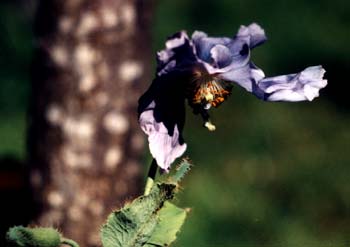
Himalayan or Tibetan Blue Poppy:
Meconopsis grandis
"Pleasures are like poppies spread
You seize the flow'r, its bloom is shed."
-Robert Burns
(1759-1796)
(1759-1796)
The Himalayan Blue Poppy Meconopsis grandis is often referred to as the world's only truly blue poppy, though there are in fact other Meconopsis species which are just as blue blue.
This species comes from the western Himalayas, inclusive of Upper Burma, Tibet & Yunnan province in China, source of so many of the finest plants today treasured for western gardening.
In 2002 we experimented with a single Blue Poppy. One plant is not enough to draw any broad conclusions, but for what it's worth, here's a complete report on our experience.
It came from a local grower who believed it should not be categorized as a "shortlived monocarpic perennial" since they've kept individual plants going since the late 1980s hence it's not all that shortlived.
I have my doubts about this claim since it is at odds with the experience of such formative authorities as Dan Hinkley. But our source claimed the trick to longevity is to get them through their first year, when they are most fragile.
Full cultivation from seeds is an ordeal & we aren't apt to go to the trouble. A young plant newly placed in the garden shouldn't be allowed to bloom the first year, though it will try to do so, as it really has to establish its roots & offsets, or it may not return in the following year.
We planted ours in spring & it attempted to bloom in summer, but we clipped the bud-stem as instructed. Then in September it produced four buds on a single stem. We clipped two of the buds before they opened, but then we weakened & permitted two of them to flower, which they did in quick succession & were not long-lasting.
We at least deadheaded before it tried to produce seeds, so hoped we hadn't harmed its chances of getting good & established. Alas, whether because we permitted a premature flowering, or because its location near the pin oak was too shady (blue poppies are bright shade rather than sun plants), it did not return the following year.
Blue Poppies are heavy feeders & should be provided with a liquid fertilizer monthly during the growing seasons, just as one would feed hardy fuschias or clematis. Ours during its short presence in the garden remained a flat rosette of leaves close to the ground, with flower stems only a foot high. Had it survived for the following year, though, it would've been quite tall, potentially three feet or taller.
We weren't inclined to try this species of blue poppy again, but some years later we could not resist trying the Tibeten Blue Poppy M. betonicifolia, which whether from greater luck or greater hardiness turned out to be the more rewarding plant.